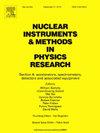Design and development of a high sensitivity radon detector based on air scintillation
IF 1.5
3区 物理与天体物理
Q3 INSTRUMENTS & INSTRUMENTATION
Nuclear Instruments & Methods in Physics Research Section A-accelerators Spectrometers Detectors and Associated Equipment
Pub Date : 2025-01-24
DOI:10.1016/j.nima.2025.170253
引用次数: 0
Abstract
Radon exposure increases the risk of lung cancer due to its radioactivity after being inhaled. Developing a highly sensitive radon detector with a low limit of detection (LLD) is urgently required to enable online monitoring and meet the need for accurate, rapid early warning at low radon concentrations (a low radiation flux). Previous experiments demonstrated that radon measurement based on air scintillation is feasible using two PMTs and the 2-fold coincidence. However, the design focused on maximizing detection efficiency for alpha particles, resulting in a low sensitivity (0.01 cpm/(Bq/m³)) and a high LLD (137.14 Bq/m³). For rapid early warning at low radon concentrations, reducing the detector's LLD is essential, which necessitates minimizing noise and enhancing sensitivity. The detector was initially designed with M/N (a majority coincidence of M fired PMTs out of N PMTs) majority coincidence logic to address the low light yield of air (about 20 ph/MeV). Simulation was then used to optimize its parameters and operational settings. Subsequently, the new detector was constructed, and its electronic circuit incorporating M/N coincidence logic was developed. Tests of the new detector revealed an experimental LLD of 8.65 Bq/m³ using 3/4 coincidence logic, a threshold of 45 mV, and a 30-min measurement period. The corresponding sensitivity reached 0.32 cpm/(Bq/m³). This technique offers a novel approach for timely and accurate radon monitoring, particularly at low concentrations, with significant implications for public health protection.
求助全文
约1分钟内获得全文
求助全文
来源期刊
CiteScore
3.20
自引率
21.40%
发文量
787
审稿时长
1 months
期刊介绍:
Section A of Nuclear Instruments and Methods in Physics Research publishes papers on design, manufacturing and performance of scientific instruments with an emphasis on large scale facilities. This includes the development of particle accelerators, ion sources, beam transport systems and target arrangements as well as the use of secondary phenomena such as synchrotron radiation and free electron lasers. It also includes all types of instrumentation for the detection and spectrometry of radiations from high energy processes and nuclear decays, as well as instrumentation for experiments at nuclear reactors. Specialized electronics for nuclear and other types of spectrometry as well as computerization of measurements and control systems in this area also find their place in the A section.
Theoretical as well as experimental papers are accepted.

 求助内容:
求助内容: 应助结果提醒方式:
应助结果提醒方式:


